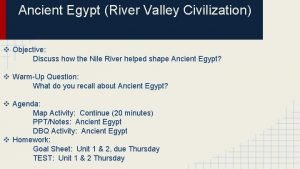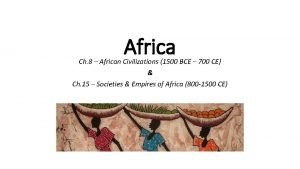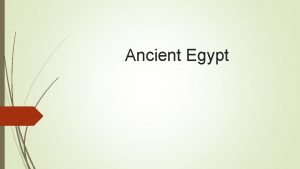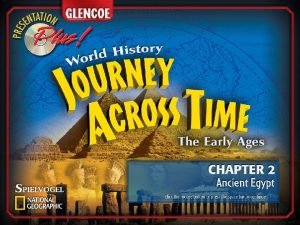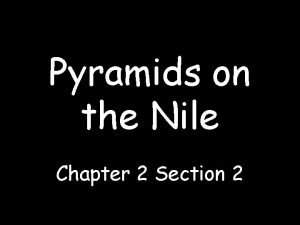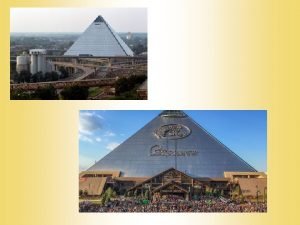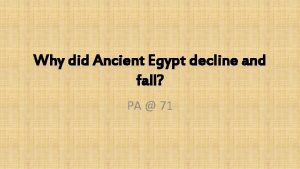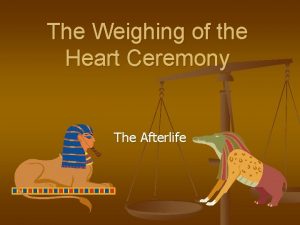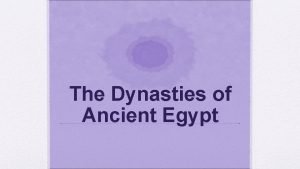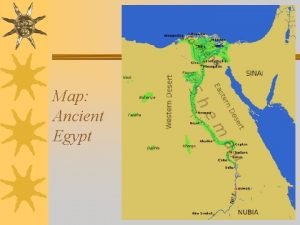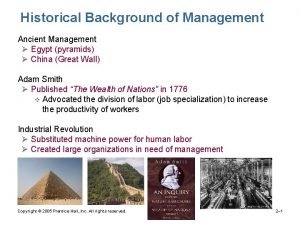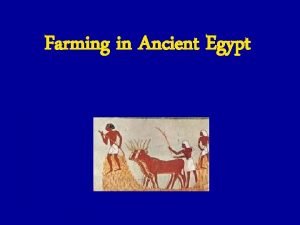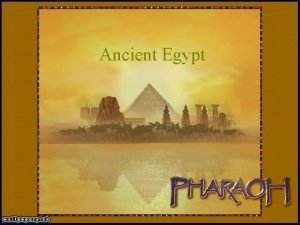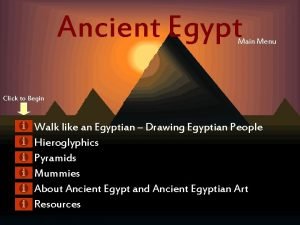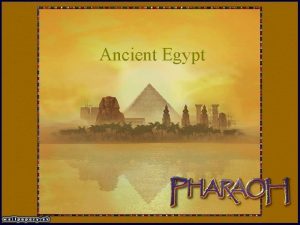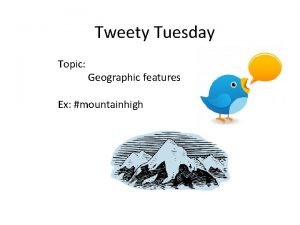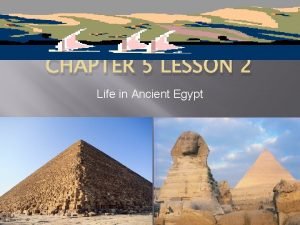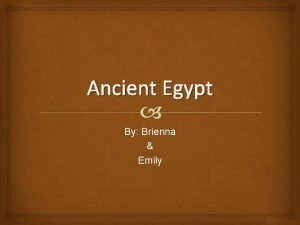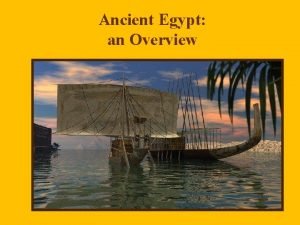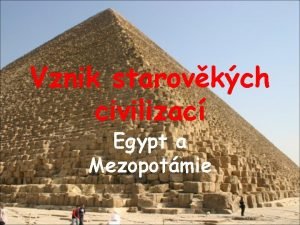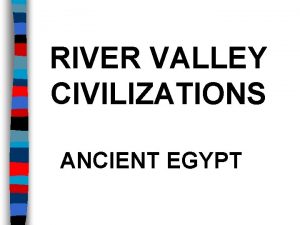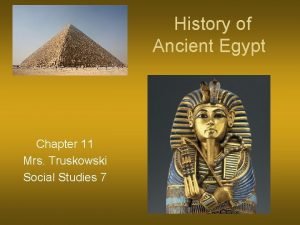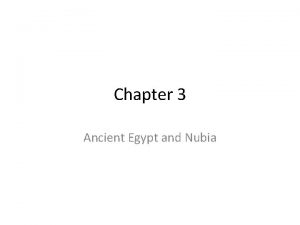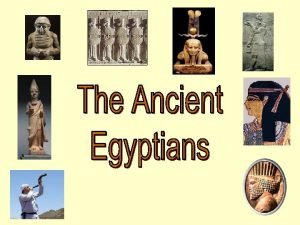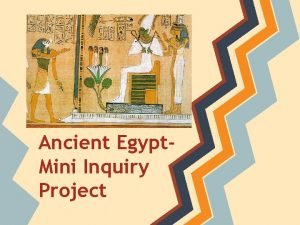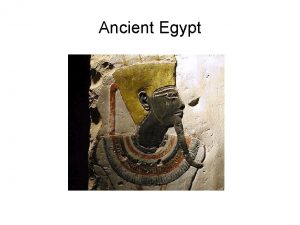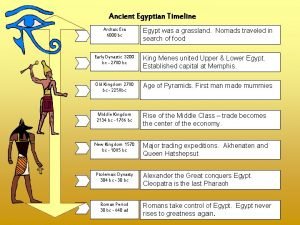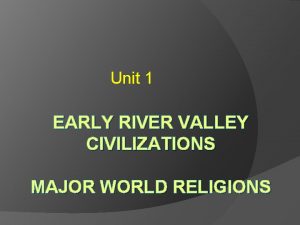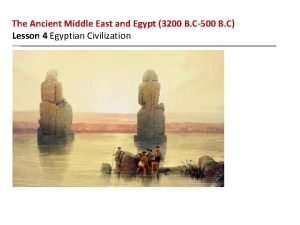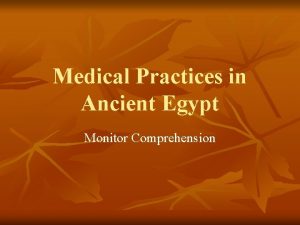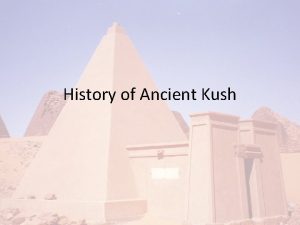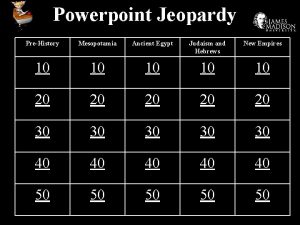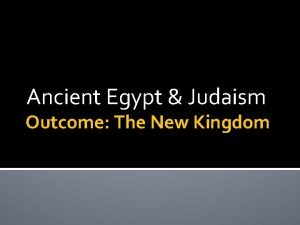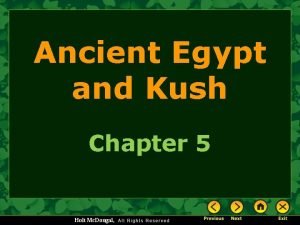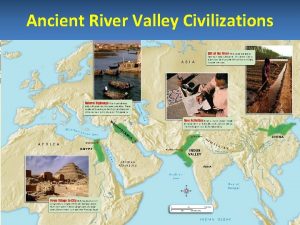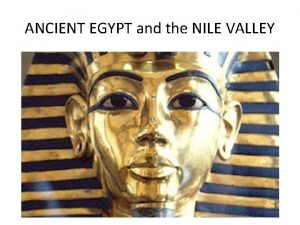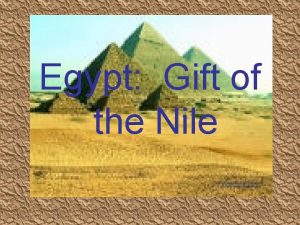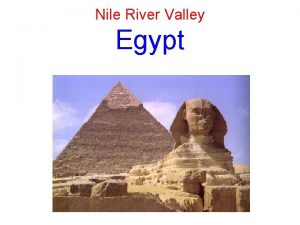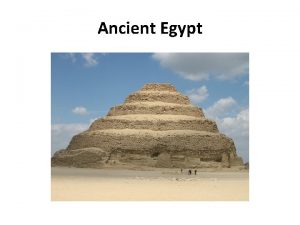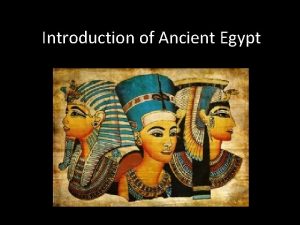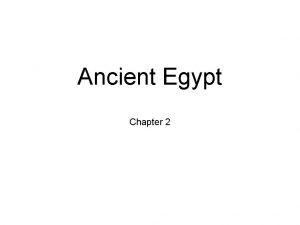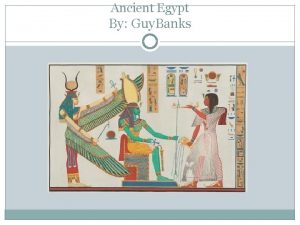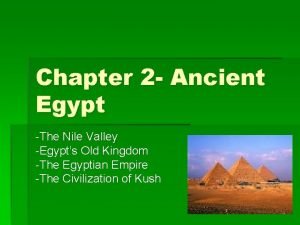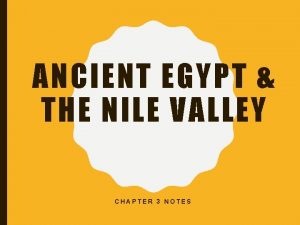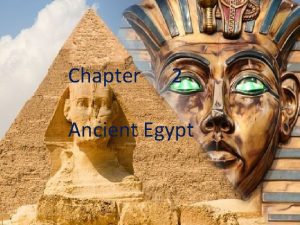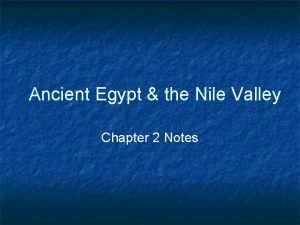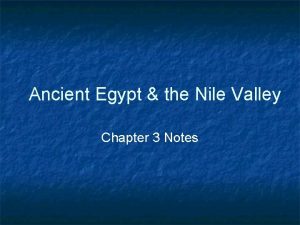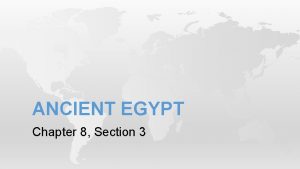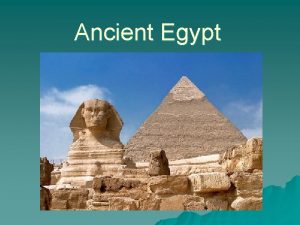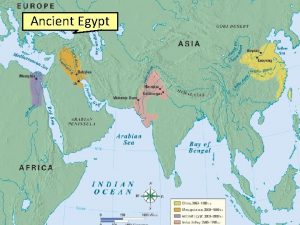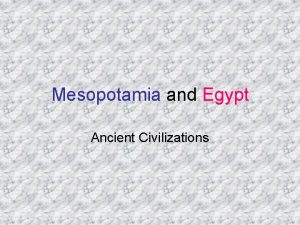Ancient Egypt The Nile Valley Chapter 2 Section































































- Slides: 63

Ancient Egypt The Nile Valley Chapter 2, Section 1 World History Mrs. Thompson

What is Egypt famous for? Pharoahs, mummies, pyramids and tombs Deserts and sand River Nile


http: //www. classzone. com/cz/books/ms_wh_survey/resources/html/animations/wh 0 4_ancientegypt. html l Egypt is in the continent of Africa. The River Nile runs through Egypt The capital of Egypt is Cairo

A View of Egypt by Satellite


The Egyptian civilization began in the fertile Nile River Valley, where natural barriers stopped invaders

Between 6000 B. C. and 5000 B. C. , groups of huntergatherers moved into the fertile Nile River Valley and settled to become the earliest Egyptians. They called they land “The Gift of the Nile” Egypt was warm and sunny but received little rainfall.



The Fertile Nile Valley

The Annual Flooding of the Nile

Egyptians relied on the Nile. They called it their “precious gift” Source of water for drinking, bathing, farming, cooking, and cleaning It provided food such as fish and supported plants And animal life The Nile is the world’s longest river!

The Nile River The Nile is about 4, 000 Miles long and flows north to the Mediterranean Sea The Nile begins as 2 rivers Blue Nile White Nile East Africa mountains Central Africa marshes These two Rivers join to form the Nile River just south of Egypt

d n a s f if l c w ro r a s n t c r a e r v o ta a s c w d o e fl l l r a e c v i s r d i e p h a t r f o d l i h t w g n m e r l Before o t f a o e t r it s r Ag e r e d l a ches t bou he Me diterra nean Sea, The N ile bra nches into tr ibutar ies that fa Over a n out n area fertile soil ca of lled the de lta.

On a map, the Nile resembles the stem of a flower and the delta looks like a flower blossom. To the west is the Sahara Desert, the largest desert in the world. To the east is the Eastern Desert which stretches to the Red Sea

Ancient Egyptians called the desert “the Red Land” Deserts formed a barrier which kept outside armies away from Egypt.

Delta marshes in north which offered no harbors for invaders approaching from the sea. Geographic Deserts to the east and west features which protected Egypt Dangerous cataracts in south which blocked enemy boats from reaching Egypt

Unlike Mesopotamians Egyptians maintained friendly contacts with the various groups settled along the Nile River Valley. Unlike Mesopotamian geography, the protective barriers kept them safe and allowed Egyptian civilization to grow and prosper.

Despite their isolation, the Mediterranean Sea and the Red Sea offered the Egyptians an outlet for trading with people outside Egypt.

People used the Nile for trade and transportation Winds from the north pushed their sailboats south. The flow of the river pushed their sailboats north.

The Egyptians depended on the Nile’s floods to grow their crops

Flooding of the Nile River Dependability Source of Flooding Season More dependable AND gentle than the Tigris and Euphrates (Egyptians were better farmers) Heavy rains from central Africa Melting snows from the highlands of east Africa July to October


When the waters of the Nile recede, a layer of dark, fertile mud is deposited on the land Egyptians called land “Kemet” or “Black Land”

Egyptians took advantage of Nile’s flooding to be successful farmers. Egyptian farmers planted grain: wheat, barley, and flax seeds. Their wide use of irrigation made Egyptian farmers successful.

Digging basins and bowl-shaped holes to hold water. Egyptian irrigation Digging canals to carry water from the basins to fields beyond the river’s reach Building levees to form walls around basins

Farming Advancements Shadoof Geometry Papyrus A bucket attached to a long pole to lift water into the basins To survey or measure the land to establish boundaries A reed plant that grew along the Nile to make baskets, sandals, river rafts, and paper.

Nile Irrigation-the Shaduf

Papyrus Paper Hieratic Scroll Piece Papyrus Plant


What was Hieroglyphic? Written on: Made up of: Symbols stood for: 1. 2. 3. Carved into: Who learned to read and write: What was their job? What gave historians the ability to read hieroglyphic?

Steps to making paper from Papyrus: 1. Cut stalks of the plant into narrow strips. 2. Soak the strips and pound them flat. 3. Air dry the strips to stiffen them. 4. Join the strips together to form a roll.


Like Mesopotamians, Egyptians a developed writing system Egyptian writing was called hieroglyphics Egyptians used papyrus rolls as writing paper It was made up of thousands of picture symbols. Egyptians used papyrus rolls as writing paper

24 “letters” + 700 phonetic symbols Some symbols stood for objects or ideas and some symbols stood for sounds. Scribes carved hieroglyphics into stone walls and monuments.

Few Egyptians learned to read and write. Some Egyptian men went to special schools to become scribes. Scribes kept records and worked for the rulers, priests, and traders.


Hieroglyphic “Cartouche”

Champollion & the Rosetta Stone


Egyptian Math 1 10 1000 10, 000 100, 000 1, 000 What number is this?

A United Egypt: Around 3100 B. C. , Egypt’s two major kingdoms, Upper and Lower Egypt were combined into one.



What created the need for government? Advances in farming, crafts, and trade created need for government Building Storing and maintaining Government rationing directed Irrigation activities grain system Settling Disputes over Land ownership

By 4000 B. C. , Egypt was made up of two large kingdoms: Lower Egypt in the Nile Delta to the north Upper Egypt At the Mouth of The Nile in the south

About 3100 B. C. , the 2 kingdoms became one Narmer of Upper Egypt, known as King Menes, led his armies to take control of Lower Egypt and created a unified Egypt. He ruled from Memphis and wore a double crown of red and white to symbolize unity of Upper and Lower Egypt.

Menes: Unifier of Upper & Lower Egypt

Narmer’s family inherited power to rule and passed it down from father to son through a line of rulers to form a dynasty Ancient Egypt was ruled by 31 different dynasties Historians group Egypt’s dynasties into 3 main periods: Old, middle, and new kingdoms

Early Egyptian Life: Egyptian society was divided into social groups based on wealth and power

Egyptian society was highly structured and divided into different social classes, each with certain responsibilities and lifestyles. httwww. classzone. com/cz/books/ms_wh_survey/resources/html/animations/wh 04_egypt social. htmlp: //

Upper Class Who Nobles, priests, government officials Location Cities and large estates along the Nile Housing Elegant homes, beautiful gardens, and pools filled with fish Work Little physical work – had servants Ruled and conducted religious ceremonies, Clothing White linen clothes, eye makeup, jewelry

Egyptian Nobility

An Egyptian Woman’s “Must. Haves” Mirror Perfume Whigs

Egyptian Priestly Class

Middle Class Who Traders, artisans, shopkeepers, scribes, and farmers (largest group) Location Smaller villages along Nile Housing Homes smaller than upper class nobles Work Important group were artisans who produced linen cloth, jewelry, pottery, and metal goods. Grew the food. Clothing Dressed in simple clothes

Ancient Egyptian Housing Middle Class Homes Peasant Homes

Egyptian Scribe

Lower Class Who Unskilled workers Location Crowded city neighborhoods Housing Small mud-brick homes with dirt floors Men Women Men did physical labor like loading cargo on boats, making and stacking mud bricks Women dried fruit, made bread, and wove cloth Worked and slept on their rooftops Clothing Very simple clothes

Scenes of Ancient Egyptian Daily Life

Father headed the family Own and pass on property Egyptian women had more rights than females in most other early civilizations Buy and sell goods Make wills and get divorces Upper-class women were in charge of temples and could perform religious ceremonies

Few children went to school mothers taught daughters to sew, cook, and run a house Children played with Board games, dolls, Spinning tops, And leather balls Fathers taught sons farming or skilled trades
 How did the nile shape ancient egypt essay
How did the nile shape ancient egypt essay How did the nile shape ancient egypt dbq answer key
How did the nile shape ancient egypt dbq answer key Aksum had access to the red sea blue nile and white nile
Aksum had access to the red sea blue nile and white nile Egypt is the gift of the nile
Egypt is the gift of the nile Janapriya nile valley
Janapriya nile valley Advanced cities ancient egypt
Advanced cities ancient egypt Why was napata location advantageous
Why was napata location advantageous Chapter 2 section 2 pyramids on the nile
Chapter 2 section 2 pyramids on the nile Upper egypt and lower egypt
Upper egypt and lower egypt A section of the nile river with rapids and rocky terrain
A section of the nile river with rapids and rocky terrain What does ancient egypt
What does ancient egypt What is ammit the god of
What is ammit the god of Egyptian floral arrangement
Egyptian floral arrangement Egypt vocabulary
Egypt vocabulary Frontalism ancient egypt
Frontalism ancient egypt Ancient egypt british council
Ancient egypt british council Specialized jobs in ancient egypt
Specialized jobs in ancient egypt Ancient egypt
Ancient egypt Ancient egypt map
Ancient egypt map Ancient management
Ancient management What crops did the ancient egyptian farmers grow
What crops did the ancient egyptian farmers grow Kalasiris egypt
Kalasiris egypt Ancient egypt transportation
Ancient egypt transportation Geographical map of ancient egypt
Geographical map of ancient egypt Ancient egypt social pyramid
Ancient egypt social pyramid Frontalism ancient egypt
Frontalism ancient egypt Ancient egypt map
Ancient egypt map Egyptian irrigation systems
Egyptian irrigation systems J
J Ancient egypt non chronological report
Ancient egypt non chronological report Social classes in ancient egypt
Social classes in ancient egypt Ancient egypt jeopardy
Ancient egypt jeopardy Ancient egypt basic needs
Ancient egypt basic needs Egypt 3 kingdoms
Egypt 3 kingdoms Kleopatra hrobka
Kleopatra hrobka Workbook page 19
Workbook page 19 Ancient egypt specialized workers
Ancient egypt specialized workers Medicine in ancient india
Medicine in ancient india How old is ancient egypt
How old is ancient egypt Economy of ancient egypt
Economy of ancient egypt Map of ancient egypt and nubia
Map of ancient egypt and nubia Ancient egypt bell ringers
Ancient egypt bell ringers Relative location of ancient egypt
Relative location of ancient egypt Ancient egypt civilization geography
Ancient egypt civilization geography Economy of ancient egypt
Economy of ancient egypt Nubia
Nubia Nubian religion
Nubian religion Ancient egypt civilization
Ancient egypt civilization Egyptian hierarchy
Egyptian hierarchy Ancient greece jeopardy
Ancient greece jeopardy Medical practices in ancient egypt answer key
Medical practices in ancient egypt answer key Map of the kingdom of kush
Map of the kingdom of kush Ancient egypt slogans
Ancient egypt slogans Mesopotamia jeopardy
Mesopotamia jeopardy Yaru ancient egypt
Yaru ancient egypt Fomro
Fomro Ancient egypt and judaism outcome the new kingdom
Ancient egypt and judaism outcome the new kingdom Easy egyptian drawings
Easy egyptian drawings Ancient egypt and kush map
Ancient egypt and kush map Map of river valley civilizations
Map of river valley civilizations Civilization ppt template
Civilization ppt template Means of communication from ancient to modern
Means of communication from ancient to modern Ancient india vs ancient china
Ancient india vs ancient china Infinitive nile
Infinitive nile

